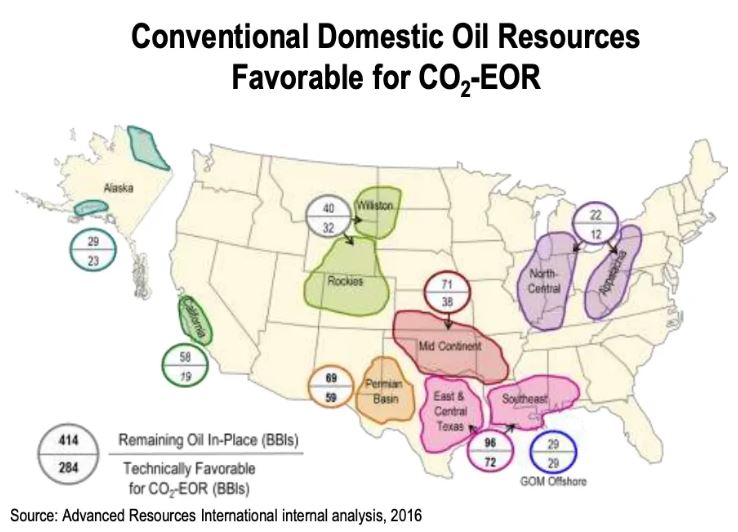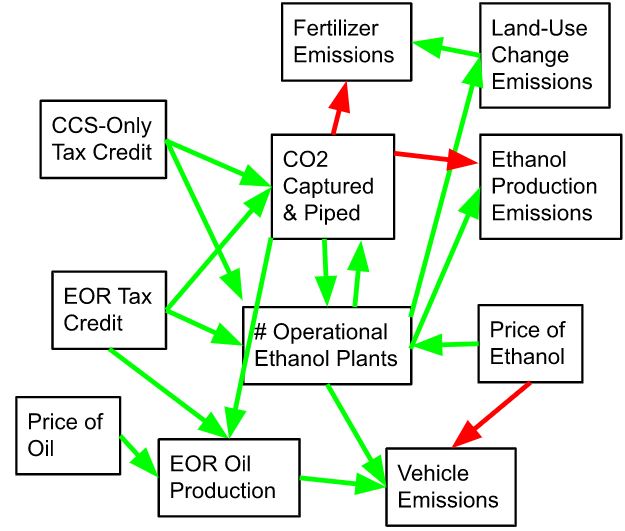Overview
As of June 2022, three large CO2 pipeline systems are proposed for the Midwest. The map below is speculative based on the facilities currently signed on, because the pipeline corporations have not finalized their routes yet. There is a clear lack of central planning and regulation for these systems overlapping each other across the region.
Summit’s proposed network would connect 33 mostly small ethanol facilities and a proposed fertilizer plant to a carbon sequestration site in North Dakota. They have partnered financially with North Dakota’s largest oil driller, Continental, and signed a carbon storage deal with Minnkota, a coal-heavy electric utility.
Navigator’s proposed network would connect 36 mostly larger ethanol and fertilizer facilities to a carbon sequestration site in Illinois. ADM/Wolf’s proposed pipeline would connect three massive corn processing facilities (ethanol and other products) to the same sequestration area.
Enhanced Oil Recovery
Captured CO2 is most commonly used for enhanced oil recovery (EOR). EOR has been used at or very near the proposed sequestration sites of each project, in both North Dakota and Illinois.

The International Energy Agency (IEA) and industry groups claim that this process can produce “carbon negative oil”. However, their own methodology indicates that conventional EOR results in 1.8x more carbon emitted than is sequestered. They also claim that “advanced EOR+” methods can result in slight net reductions in carbon emissions, but they are evaluating these scenarios while assuming that all oil demand must and will be met, and that EOR oil mostly displaces other oil in the market.

In reality, there is a finite amount of oil on Earth, and much of it is only accessible by using EOR. While CO2 injection is not the only major method of EOR, any restriction in supply of CO2 used for EOR would increase the likelihood of more oil remaining in the ground. Research shows that over 60% of oil & fossil gas must remain in the ground in order for us to meet the goals of the Paris Climate Agreement.
Regardless of how advanced the EOR process is, there are better ways to do carbon sequestration (i.e. chemical storage or mineral storage) that don’t involve oil, and also have less risk of CO2 leakage. Speaking of leakage, CO2 pipelines pose tremendous risks to environmental and human health from rupture and leakage, which we won’t elaborate on here, but this piece on the Satartia Incident is essential reading.
Ethanol Lifecycle Emissions
The Midwest CO2 pipeline systems allow the ethanol, fertilizer, and potentially other polluting industries to collect tax credits for CCS, thereby subsidizing and enabling their continued operation. We attempt to represent the systems and feedback loops with a flowchart below:

Green = positive relationship, red = inverse relationship.
Ethanol plant owners and operators who have signed on with a CO2 pipeline corporation have said that these CCS tax credits are necessary for them to continue to compete and operate in today’s markets. Ethanol producers are literally trying to stay in business by partaking. A Summit executive stated a goal of providing “longevity for the community’s ethanol plant.” The Ethanol Industry as a whole recognizes the need for CO2 pipelines to keep them competitive.
Yes, an ethanol facility can lower its carbon footprint by doing CCS via CO2 pipelines, but if those systems enable the continued existence of the ethanol industry, then they will overall be bad for the climate. This is mainly due to global land use change, fertilizer use, and the fuel market rebound effect.
The 68 ethanol plants that have signed onto the 3 Midwest CO2 pipeline systems thus far total 10.7 Million metric tons of annual CO2 emissions (3 year average), but their full capacity lifecycle emissions are calculated at 72.5 MMT/yr. If even 15% of these ethanol plants (in terms of production capacity) can attribute their continued operation to CO2 pipelines and tax credits, then that will mean CO2 pipelines cause a net increase in GHG emissions.
| Pipeline System | Ethanol CO2 Captured (MMT/yr) | Total Ethanol Emissions (MMT/yr) | % Emissions Sequestered |
| ADM/Wolf | 2.22 | 10.83 | 20.5% |
| Navigator | 5.11 | 35.28 | 14.5% |
| Summit | 3.40 | 26.42 | 12.9% |
| Total | 10.73 | 72.54 | 14.8% |
Lastly, there are several critical opportunity costs of growing corn for ethanol in the Midwest. An acre of solar panels in Iowa can produce 34 times more energy as an acre of corn grown for ethanol would. Maybe even 100 times more. Ethanol offsets just 6% of U.S. gasoline use, and just a 2 mpg increase in fuel economy would offset as much. Growing plants for fuel instead of food is worsening the global food crisis, in addition to the climate crisis.
Conclusion
Both EOR and ethanol lifecycle emissions on their own are reason enough to declare that CO2 pipelines are very likely to cause a net increase in GHG emissions. When we combine those two main factors, and add the electricity sector emissions from pipeline compressor stations, it’s not even close. Obviously, anyone in the Midwest who cares about climate change should oppose these CO2 pipeline systems.
